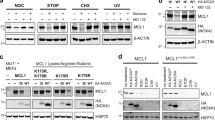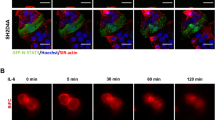Abstract
The MUC1 heterodimeric transmembrane glycoprotein is aberrantly overexpressed by most human carcinomas. The MUC1 C-terminal subunit localizes to mitochondria and blocks stress-induced activation of the intrinsic apoptotic pathway. How MUC1 is delivered to mitochondria is not known. The present studies demonstrate that MUC1 forms intracellular complexes with HSP70 and HSP90. We show that the MUC1 cytoplasmic domain binds directly to HSP70 in vitro. By contrast, binding of MUC1 to HSP90 in vitro is induced by c-Src-mediated phosphorylation of the MUC1 cytoplasmic domain. c-Src also increases binding of MUC1 to HSP90 in cells. In concert with these results, we show that heregulin (HRG), a ligand for ErbB receptors, activates c-Src and, in turn, stimulates binding of MUC1 to HSP90. We also show that inhibitors of c-Src or HSP90 block HRG-induced targeting of MUC1 to mitochondria and integration of MUC1 into the mitochondrial outer membrane. These findings indicate that MUC1 is delivered to mitochondria by a mechanism involving activation of the ErbB receptor → c-Src pathway and transport by the molecular chaperone HSP70/HSP90 complex.
This is a preview of subscription content, access via your institution
Access options
Subscribe to this journal
Receive 50 print issues and online access
$259.00 per year
only $5.18 per issue
Buy this article
- Purchase on Springer Link
- Instant access to full article PDF
Prices may be subject to local taxes which are calculated during checkout







Similar content being viewed by others
References
Baldus SE, Monig SP, Huxel S, Landsberg S, Hanisch FG, Engelmann K et al. (2004). Clin Cancer Res 10: 2790–2796.
Belsches-Jablonski AP, Biscardi JS, Peavy DR, Tice DA, Romney DA, Parsons SJ . (2001). Oncogene 20: 1465–1475.
Bukau B, Deuerling E, Pfund C, Craig EA . (2000). Cell 101: 119–122.
Croce MV, Isla-Larrain MT, Rua CE, Rabassa ME, Gendler SJ, Segal-Eiras A . (2003). J Histochem Cytochem 51: 781–788.
Datta R, Oki E, Endo K, Biedermann V, Ren J, Kufe D . (2000). J Biol Chem 275: 31733–31738.
Gendler S, Taylor-Papadimitriou J, Duhig T, Rothbard J, Burchell JA . (1988). J Biol Chem 263: 12820–12823.
Hartl FU, Hayer-Hartl M . (2002). Science 295: 1852–1858.
Huang L, Ren J, Chen D, Li Y, Kharbanda S, Kufe D . (2003). Cancer Biol Ther 2: 702–706.
Kharbanda S, Saleem A, Yuan Z-M, Kraeft S, Weichselbaum R, Chen LB et al. (1996). Cancer Res 56: 3617–3621.
Kinlough CL, Poland PA, Bruns JB, Harkleroad KL, Hughey RP . (2004). J Biol Chem 279: 53071–53077.
Kufe D, Inghirami G, Abe M, Hayes D, Justi-Wheeler H, Schlom J . (1984). Hybridoma 3: 223–232.
Levitan F, Stern O, Weiss M, Gil-Henn C, Ziv R, Prokocimer Z et al. (2005). J Biol Chem (in press).
Li Y, Bharti A, Chen D, Gong J, Kufe D . (1998). Mol Cell Biol 18: 7216–7224.
Li Y, Chen W, Ren J, Yu W, Li Q, Yoshida K et al. (2003a). Cancer Biol Ther 2: 187–193.
Li Y, Kuwahara H, Ren J, Wen G, Kufe D . (2001a). J Biol Chem 276: 6061–6064.
Li Y, Liu D, Chen D, Kharbanda S, Kufe D . (2003b). Oncogene 22: 6107–6110.
Li Y, Ren J, Yu W-H, Li G, Kuwahara H, Yin L et al. (2001b). J Biol Chem 276: 35239–35242.
Li Y, Yu W-H, Ren J, Huang L, Kharbanda S, Loda M et al. (2003c). Mol Cancer Res 1: 765–775.
Ligtenberg MJ, Kruijshaar L, Buijs F, van Meijer M, Litvinov SV, Hilkens J . (1992). J Biol Chem 267: 6171–6177.
Merlo G, Siddiqui J, Cropp C, Liscia DS, Lidereau R, Callahan R et al. (1989). Cancer Res 49: 6966–6971.
Moro F, Sirrenberg C, Schneider HC, Neupert W, Brunner M . (1999). EMBO J 18: 3667–3675.
Ng FW, Nguyen M, Kwan T, Branton PE, Nicholson DW, Cromlish JA et al. (1997). J Cell Biol 139: 327–338.
Ogawa H, Ishiguro K, Gaubatz S, Livingston DM, Nakatani Y . (2002). Science 296: 1132–1136.
Park SJ, Suetsugu S, Takenawa T . (2005). EMBO J 24: 1557–1570.
Perey L, Hayes DF, Maimonis P, Abe M, O'Hara C, Kufe DW . (1992). Cancer Res 52: 2563–3568.
Rahn JJ, Dabbagh L, Pasdar M, Hugh JC . (2001). Cancer 91: 1973–1982.
Ren J, Agata N, Chen D, Li Y, Yu W-H, Huang L et al. (2004). Cancer Cell 5: 163–175.
Ren J, Li Y, Kufe D . (2002). J Biol Chem 277: 17616–17622.
Ryan MT, Voos W, Pfanner N . (2001). Methods Cell Biol 65: 189–215.
Schroeder J, Thompson M, Gardner M, Gendler S . (2001). J Biol Chem 276: 13057–13064.
Schroeder JA, Masri AA, Adriance MC, Tessier JC, Kotlarczyk KL, Thompson MC et al. (2004). Oncogene 23: 5739–5747.
Shi Y, Sawada J, Sui G, Affar el B, Whetstine JR, Lan F et al. (2003). Nature 422: 735–738.
Siddiqui J, Abe M, Hayes D, Shani E, Yunis E, Kufe D . (1988). Proc Natl Acad Sci USA 85: 2320–2323.
Truscott KN, Brandner K, Pfanner N . (2003). Curr Biol 13: R326–R337.
Vadlamudi RK, Sahin AA, Adam L, Wang RA, Kumar R . (2003). FEBS Lett 543: 76–80.
Wada J, Kanwar YS . (1998). Proc Natl Acad Sci USA 95: 144–149.
Wei X, Xu H, Kufe D . (2005). Cancer Cell 7: 167–178.
Wen Y, Caffrey T, Wheelock M, Johnson K, Hollingsworth M . (2003). J Biol Chem 278: 38029–38039.
Whitesell L, Mimnaugh EG, De Costa B, Myers CE, Neckers LM . (1994). Proc Natl Acad Sci USA 91: 8324–8328.
Yamamoto M, Bharti A, Li Y, Kufe D . (1997). J Biol Chem 272: 12492–12494.
Yin L, Kufe D . (2003). J Biol Chem 278: 35458–35464.
Young JC, Hartl FU . (2000). EMBO J 19: 5930–5940.
Young JC, Hoogenraad NJ, Hartl FU . (2003). Cell 112: 41–50.
Acknowledgements
This work was supported by Grant CA97098 awarded by the National Cancer Institute. We acknowledge Drs Y Nakatani and J Swada for the pOZ-N vector and helpful advice, and also Kamal Chauhan for technical support.
Author information
Authors and Affiliations
Corresponding author
Rights and permissions
About this article
Cite this article
Ren, J., Bharti, A., Raina, D. et al. MUC1 oncoprotein is targeted to mitochondria by heregulin-induced activation of c-Src and the molecular chaperone HSP90. Oncogene 25, 20–31 (2006). https://doi.org/10.1038/sj.onc.1209012
Received:
Revised:
Accepted:
Published:
Issue Date:
DOI: https://doi.org/10.1038/sj.onc.1209012
Keywords
This article is cited by
-
Comparison of mucin-1 in human breast cancer and canine mammary gland tumor: a review study
Cancer Cell International (2022)
-
The oncoprotein MUC1 facilitates breast cancer progression by promoting Pink1-dependent mitophagy via ATAD3A destabilization
Cell Death & Disease (2022)
-
Immune senescence in multiple myeloma—a role for mitochondrial dysfunction?
Leukemia (2022)
-
Targeting MUC1-C suppresses BCL2A1 in triple-negative breast cancer
Signal Transduction and Targeted Therapy (2018)
-
Targeting MUC1-C inhibits the AKT-S6K1-elF4A pathway regulating TIGAR translation in colorectal cancer
Molecular Cancer (2017)



